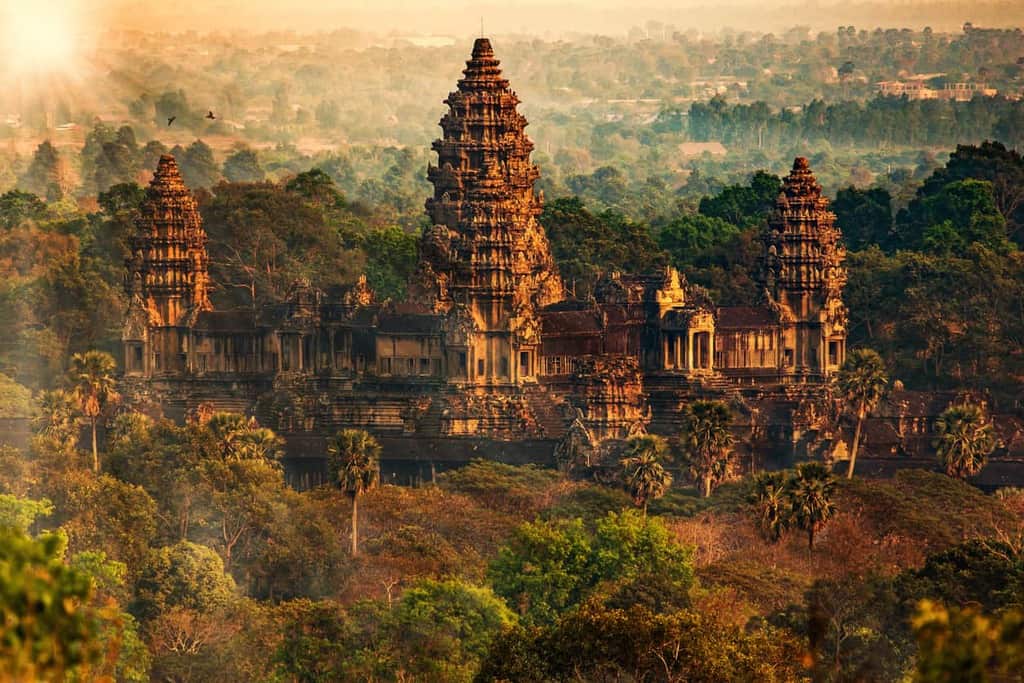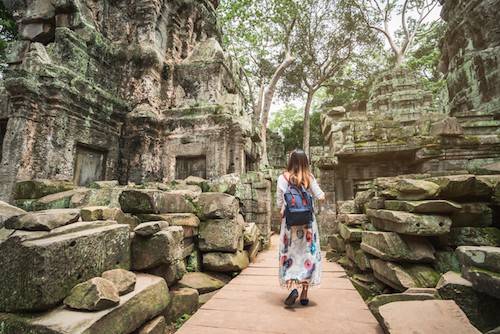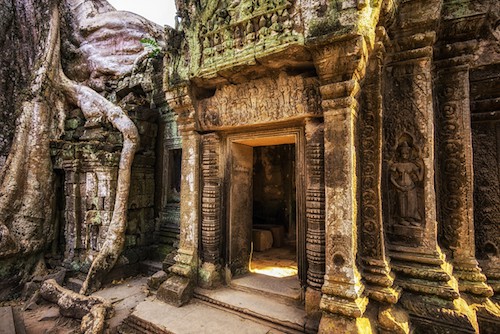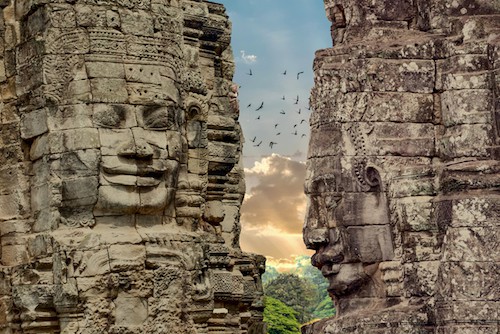Angkor. The capital city of the powerful, sophisticated, and prosperous Khmer Empire in times long past was a place where kings built magnificent temples as abodes for gods. The reigning king endeavored to surpass the accomplishments of his predecessor by constructing temples to be without question the only worldly place befit for a god.
The temple structures evolved over the years, eventually leading to Angkor Wat, the world’s largest religious structure, an architectural masterpiece of epic proportions, the national symbol of Cambodia, and considered the jewel of Khmer. While Angkor Wat draws most tourists from Siem Reap, there are numerous striking temples and ruins from the 9th to 15th centuries within the expansive Angkor Archaeological Park.
Wander around the temples of Angkor, a UNESCO World Heritage Site, get lost in the history, and marvel at the brilliance, magnitude, symmetry, and artistry of these temples built to resemble imposing and elaborate stone-carved mountains surrounded by dense forestry.
When Cambodia is the “Least” Hot
The climate in Cambodia is quite hot all year long. While the temperature itself is not outrageously high, the humidity and still air makes it feel much hotter than it actually is. March through May are the hottest months with average temperatures above 93°F. The rainy season spans around May through October. The optimal time to visit is from early December through early February when the temperature and humidity are slightly more moderate. Naturally, this also corresponds to it being the most crowded.
Things to Know Before Traveling to Angkor
The official language is Khmer. The traditional manner of greeting in Cambodia is by placing the palms of your hands together as if to pray while bowing your head. While the official currency is the Cambodian riel, the U.S. dollar is widely used and accepted. Most prices (at least in touristy areas) were quoted in U.S. currency.
Nearest Airport to Angkor Wat
Travel to Siem Reap
Fly into Cambodia’s Siem Reap International Airport and you’ll be a short ~12 minute drive from the impressive Angkor Wat. You can search for flight deals here.
As far as I know, foreigners are not permitted to drive inside the temple complex. To get around the expansive park, you can hire a private driver, private guide, book a group bus tour, arrange taxis, or tuk tuks. Many tuk tuk drivers are excellent, but scams are commonplace. It’s recommended to book ahead with a reputable company or through your hotel if you intend to use this mode of transportation. Renting scooters and bicycles are other options.
Take a look at some of these luxury, yet affordable, hotel options around Siem Reap.
ICS Travel Group arranged all of our private guides in Siem Reap and throughout our Southeast Asia trip. Every guide was timely, friendly, charismatic about history, and provided tremendous insights we would have overlooked completely without their leadership. Having private guides allowed ultimate flexibility and the ability to tour the temples at our own pace without being stuck to the whims and paces of others.
Where to Stay in Siem Reap
The Angkor Palace Resort and Spa provides elegance, all the modern comforts, impeccable service, fine dining, a large and eloquent pool area providing a relaxing resort atmosphere, and an enviable location less than a 10 minute drive from the airport and ~15 minutes from Siem Reap’s beloved temples. Our favorite on-site restaurant, the Plum Kreus Khmer, offered a pre-set menu that gave us the opportunity to try a variety of Cambodian local dishes. The tables were about a foot off the ground and we sat on soft cushions instead of chairs.
Angkor Village Hotel and Chez Moi Suite and Spa are additional hotel options. You can also search for Siem Reap hotel deals on TripAdvisor.
Visa and Vaccination Information for Cambodian Travel
Before traveling to Cambodia, visit the Embassy of the Kingdom of Cambodia’s website for the most current visa and tourist information. Obtaining our Cambodian visas online was quick and simple. We filled out an electronic short application form, submitted a passport size photo, paid our fee, and were emailed our visas to stick into our passport in less than 3 days.
Check the CDC’s list of recommended vaccinations and eating and drinking safety recommendations.
IMPORTANT Winetraveler Tip: The CDC recommends not drinking the tap water, or eating undercooked fish or meat, and raw or unpeeled fruits and vegetables that haven’t been washed in clean water.
Angkor Wat Temple Ticket Information
Touring the temples requires a ticket that is purchased at an on-site ticketing center. The 1 day pass is $37, $62 for a 3 day pass, and $72 for a 7 day pass (as of January 2020). The entry tickets are nontransferable, which is strictly enforced by adorning your photograph to your ticket. Do not lose your ticket. Expect your ticket to be checked several times throughout your touring. Our tickets were scrutinized each time we started walking toward a new temple.
Winetraveler Tip: Proper temple attire is required while visiting the temples. You don’t have to dress fancy, but shoulders and knees must be covered and revealing clothing is strictly prohibited and enforced. Wear comfortable shoes, lightweight and breathable clothing, drink plenty of water, and expect to walk a lot around temples completely exposed to the sun. There is no air condition anywhere. During our aggressive day of touring around the temples, we walked over 9 miles.
DAY 1
Angkor Wat at Sunset
Acquaint yourself with Angkor Wat, translated to mean “City Temple”, by arriving before sunset on your first day. Crowd around the outskirts of the temple opposite the massive moat along with a constantly growing number of tourists and many adorable monkeys.
Winetraveler Tip: Before watching the sunset is an excellent time to purchase your temple passes.
To describe Angkor Wat as magnificent is an understatement. The construction of this iconic temple started over 900 years ago around 1113. It was dedicated to the Hindu god, Vishnu, and believed to have been built to be a mausoleum for the king. It subsequently became a Buddhist temple. History and tales of everyday life are told through the bas reliefs on the walls.
Angkor Wat is impressive because of its beautiful design, symmetrical layout, immense size spanning more than 400 acres, mortar free construction, and the multitude of intricate and detailed carvings. Five soaring towers shaped like a lotus flower symbolize the mountain ranges of Mt. Meru, the home of the Hindu gods. The square-shaped moat and surrounding enclosure walls represent the ocean and mountain ranges. The highest spire reaches a height of 213 ft. The moat is ~650 ft. wide with a perimeter over 3 miles.
DAYS 2-3
While it is possible to see the temples listed below in one long day, I’d recommend spreading it over at least two days as there’s many things to see. If you have extra time, tour more temples, relax poolside, take cooking classes, such as at Lily’s Secret Garden Cooking Class, go on a tethered balloon ride over Angkor, and/or explore Siem Reap’s Kompong Phluk floating village.
Angkor Wat at Sunrise
Drive through the dark streets to Angkor Wat during the wee hours of the morning, around 4 am, along with what may appear to be thousands of other eager tourists with the same ambition of seeing Angkor Wat at sunrise. Bring a flashlight, a picnic breakfast, and walk over the bridge across the expansive moat, through the entry doors of the surrounding walls, and then wait for the sunlight to creep up above the temple. Shimmers of light slowly reveal the temple’s silhouette that is also reflected in the lake.
It’s recommended to tour this temple early in the morning before the heat gets too intense as the grounds are enormous.
Ta Prohm Temple
The Ta Prohm Temple, a Buddhist temple built in 1186 for the king’s mother, is referred to as the Jungle Temple. It is also known as the Tomb Raider Temple since segments of the Tomb Raider movie were filmed at this temple. What makes this temple unique is that it is completely devoured by the jungle providing a glimpse of how most temples appeared when European explorers first encountered them. The structure is crumbling in parts. Massive and long roots weave around and encroach the grayish colored stones while branches and tall trunks grow out of the temple. The jungle atmosphere is wild and mysterious accentuating nature’s destructive power. It feels like you’re walking around in a fairy tale, or an Indiana Jones movie.
Pre Rup Temple
The reddish-colored Pre Rup Temple, translating to mean “turning of the body” in reference to the cremation method, is known as the Pyramid Temple. It is a three-level pyramidal shaped temple made from brick, laterite, and sandstone with the remains of 5 lotus flower spires on the top tier. Its construction precedes that of Angkor Wat, and was built in 961 in dedication to the Hindu god, Shiva. Climbing up the steep stairs of the 3-story high central tower offers stunning views of the surrounding forestry, the blueprint of the below temple structure, and we could see the towers of Angkor Wat in the distance extending above the treetops.
The temple was not crowded during our late morning visit. We were informed tourists commonly flood here for sunrise and sunset largely to marvel at the coloring of the structure during these times.
Banteay Samre Temple
The Banteay Samre Temple was described to us as being a miniature Angkor Wat based on the similarities between the design and engravings. It was built in the same time period as the Angkor Wat, and like the Angkor Wat was also dedicated to the Hindu god, Vishnu. The Banteay Samre is much smaller, compact, and has only one tower in the shape of a lotus flower. It almost felt secluded as it isn’t on the route of many tour buses.
Banteay Srei Temple
The small Banteay Srei Temple, dedicated to the Hindu Shiva god, is considered by many as the “Jewel of Khmer Art” based on its exquisite well-preserved decorations. It is made of pink sandstone, which stood up over the years far better than the gray stone of the other temples. The intricate surviving detail of the carvings and engravings is simply astounding and provides a flavor of how the other temples may have appeared before being caught in an unforgiving battle with time and nature.
It was at least a 30 minute drive from the other temples we had explored (all of which were much closer together), but it’s worth the drive. You may find the drive to be a welcome break from the heat.
Angkor Thom City
Angkor Thom, meaning the Great City, was an expansive fortified city and the last capital of the Khmer Empire established in the late 12th or early 13th century. The shape of the city is a perfectly symmetrical large square with five gateways and a wide moat surrounding the city.
Bayon Temple
The Buddhist Bayon Temple, located in the dead center of Angkor Thom, is adored by many because of its many faces. It’s believed the central location of this temple is symbolic of Mt. Meru being at the center of the universe. We were entranced by the temple’s most notable feature, its ~200 remaining gigantic stone faces carved onto each side of the temple’s many towers smiling down at us from every angle.
At the time of the temple’s construction, there were 54 towers with each tower having a very large face carved into the stone on each of the 4 sides of the tower, equating to 216 unique faces. No two faces are identical and each face points toward a cardinal direction: North, South, East, or West. It is believed each tower was representative of one of the 54 provinces in Cambodia during the time of the Khmer Empire.
Don’t miss Angkor Thom’s well-preserved South Gate. Aside from the stunning and impressive stone tower gate, there’s a long causeway extending across a moat. The statues tell the story of the Churning of the Ocean of Milk. There is a series of 54 asuras (demon gods) statues on one side with a series of 54 devas (guardian gods) statues on the other side. Both sides are holding a giant naga (serpent) engaging in a game of tug-of-war.
Other popular sites within the Angkor Thom walls, include the Baphuon Temple, Phimeanakas, and the Terraces of the Elephants and the Leper King.



